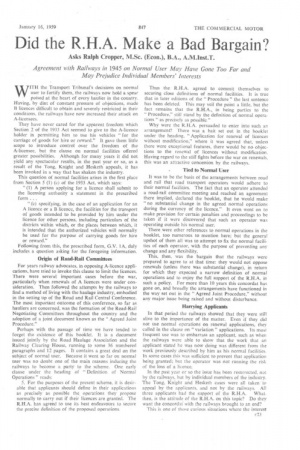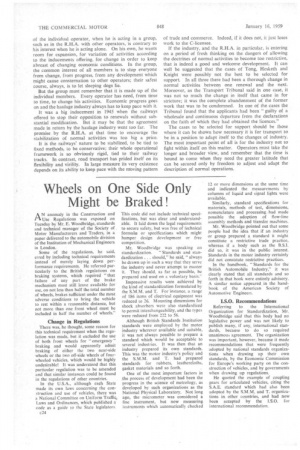Did the R.H.A. Make a Bad Bargain?
Page 59

Page 60

If you've noticed an error in this article please click here to report it so we can fix it.
Asks Ralph Cropper, M.Sc. (Econ.), B.A., A.M.Inst.T.
Agreement with Railways in 1945 on Normal User May Have Gone Too Far and May Prejudice Individual Members' Interests
WITH the Transport Tribunal's decisions on normal user to fortify them, the railways now hold a spear
• poised at the heart of every haulier in the country. Having, by dint of constant pressure of objections, made B licences difficult to obtain and severely restricted in their conditions, the railways have now increased their attack on A-licensees.
They have never cared for the apparent freedom which Section 2 of the 1933 Act seemed to give to the A-licence holder in permitting him to use his vehicles "for the carriage of goods for hire or reward." It gave them little scope to introduce control over the freedom of the A-licensee, but the clause on normal facilities offered greater possibilities. Although for many years it did not yield any spectacular results, in the past year or so, as a result of the Tong, Knight and Hesketh appeals, it has been invoked in a way that has shaken the industry.
This question of normal facilities arises in the first place from Section 5 (1) (c) of the 1933 Act, which says: "(I) A person applying for a licence shall submit to the licensing authority a statement in the prescribed form. ..
"(c) specifying, in the case of an application for an A licence or a B licence, the facilities for the transport of goods intended to be provided by him under the licence for other persons, including particulars of the districts within which, or the places between which, it is intended that the authorized vehicles will normally be used for the purpose of carrying goods for hire or reward."
Following from this, the prescribed form, G.V. 1A, duly includes a question asking for the foregoing information.
Origin of Road-Rail Committees
For years railway advocates, in opposing A-licence applications, have tried to invoke this clause to limit the licences. There were several important cases before the war, particularly when renewals of A licences were under consideration. Then followed the attempts by the railways to find a method of living with the haulage industry, embodied in the setting up of the Road and Rail Central Conference. The most important outcome of this conference, so far as hauliers are concerned, was the formation of the Road-Rail Negotiating Committees throughout the country and the adoption of a joint document known as the " Agreed Joint Procedure."
Perhaps with the passage of time we have tended to forget the existence of this booklet. It is a document issued jointly by the Road Haulage Association and the Railway Clearing House, running to some 36 numbered paragraphs and 12 pages. It contains a great deal on the subject of normal user. Because it went so far on normal user was no doubt one of the main reasons inducing the railways to become a party to the scheme. One early clause under the heading of " Definition of Normal Operations" reads; 5. For the purposes of the present scheme, it is desirable that applicants should define in their applications as precisely as possible the, operations they propose normally to carry out if their licences are granted. The R.H.A. has agreed to use its best endeavours to secure the precise definition of the proposed operations.
Thus the R.H.A. agreed to commit themselves to securing close definitions of normal facilities. It is true that in later editions of the " Procedure " the last sentence has been deleted. This may veil the point a little, but the fact remains that the R.H.A., in being parties to the "Procedure," still stand by the definition of normal operations "as precisely as possible."
Why were the R.H.A. persuaded to enter into such an arrangement? There was a bait set out in the booklet under the heading, "Application for renewal of licences without modification," where it was agreed that, unless there were exceptional features, there would be no objections to the renewal of licences without modification. Having regard to the stiff fights before the war on renewals, this was an attractive concession by the railways.
Tied to Normal User
It was to be the basis of the arrangements between road and rail that road transport operators would adhere to their normal facilities. The fact that an operator attended a road-rail committee meeting and reached an agreement there implied, declared the booklet, that he would make "no substantial change in the agreed normal operations during the currency of the licence." It even went on to make provision for certain penalties and proceedings to be taken if it were discovered that such an operator was operating outside his normal user.
There were other references to normal operations in the booklet, too numerous to mention here; but the general upshot of them all was to attempt to fix the normal facilities of each operator, with the purpose of preventing any change and any flexibility.
This, then, was the bargain that the railways were prepared to agree to at that time: they would not oppose renewals (unless there was substantial change), in return for which they expected a narrow definition of normal operations and to enjoy the full support of the R.H.A. in such a policy. For more than 10 years this concordat has gone on, and broadly the arrangements have functioned in the way set out in the "Agreed Joint Procedure," without any major issue being raised and without disturbance.
Harrying Applicants
In that period the railways showed that they were still alive to the importance of the matter. Even if they did not use normal operations on renewal applications, they called in the clause on " variation " applications. Its most frequent use was to embarrass an applicant, such as when the railways were able to show that the work that an applicant stated he was now doing was different from the work previously described by him as his normal facilities. In some cases this was sufficient to prevent that application being granted; but the operator was not running the risk of the loss of a licence.
In the past year or so the issue has been resurrected, not by the railways. but by individual members of the industry. The Tong, Knight and Hesketh casts were all taken ' to appeal by the applicants, and not by the railways. All
three applicants had the support of the R.H.A. What, then, is the attitude of the R.H.A. on this topic? Do they want the concordat with the railways brought to an end?
This is one of those curious situations where the interest of the individual operator, when he is acting in a group, such as in the R.H.A. with other operators, is contrary to his interest when he is acting alone. On his own, he wants room for expansion, for variation of activities according to the inducements offering, for change in order to keep abreast of changing economic conditions. In the group, the common interest of all members is to stop everyone from change, from progress, from any development which might cause consternation to other operators; their safest course, always, is to let sleeping dogs lie.
But the group must remember that it is made up of the individual members. Every operator has need, from time to time, to change his activities. Economic progress goes on and the haulage industry always has to keep pace with it.
It was a big inducement in 1945 when the railways offered to stop their opposition to renewals without substantial modification. But it may be that the agreement made in return by the haulage industry went too far. The promise by the R.H.A. at that time to encourage the stabilization of normal activities was too big a price.
It is the railways' nature to be stabilized, to be tied to fixed methods, to be conservative; their whole operational framework is so obviously rigid, tied to their railway tracks. In contrast, road transport has prided itself on its flexibility and virility. In large measure its very existence depends on its ability to keep pace with the moving pattern of trade and commerce. Indeed, if it does not, it just loses work to the C-licensee.
If the industry, and the R.H.A. in particular, is entering on a period of fresh thinking on the dangers of allowing the doctrines of normal activities to become too restrictive, that is indeed a good and welcome development. It can well be suggested that the cases of Tong, Hesketh and Knight were possibly not the best to be selected for support. In all three there had been a thorough change in normal activities between one renewal and the next. Moreover, as the Transport Tribunal said in one case, it was not so much the change in itself that came in for stricture; it was the complete abandonment of the former work that was to be condemned. In one of the cases the Tribunal found that the applicants had been "guilty of a wholesale and continuous departure from the declarations on the faith of which they had obtained the licences."
The cases to be selected for support should be those where it can be shown how necessary it is for transport to be in a position to adapt itself to the changes of industry. The most important point of all is for the industry not to fight within itself on this matter. Operators must take the longer and broader view, and remember that the time is bound to come when they need the greater latitude that can be secured only by freedom to adjust and adapt the description of normal operations.








































































































